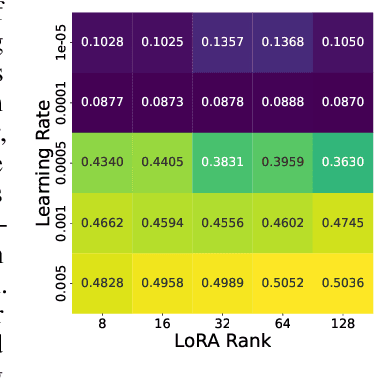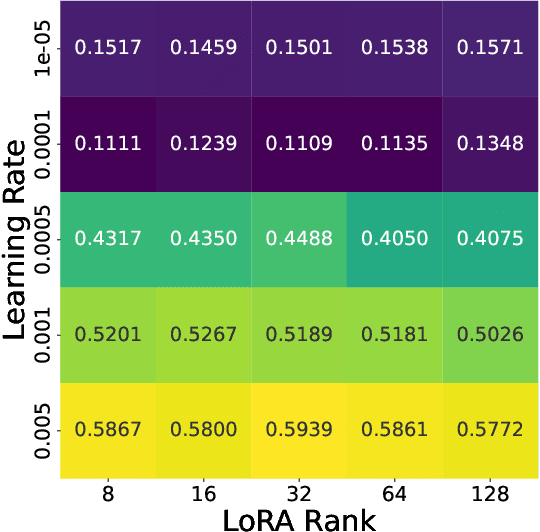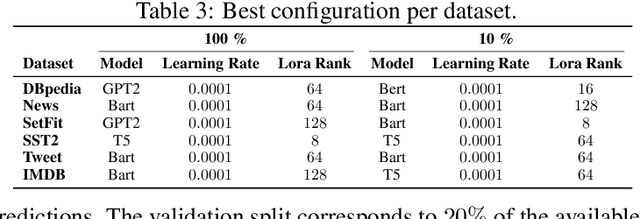Lennart Purucker
nanoTabPFN: A Lightweight and Educational Reimplementation of TabPFN
Nov 05, 2025Abstract:Tabular foundation models such as TabPFN have revolutionized predictive machine learning for tabular data. At the same time, the driving factors of this revolution are hard to understand. Existing open-source tabular foundation models are implemented in complicated pipelines boasting over 10,000 lines of code, lack architecture documentation or code quality. In short, the implementations are hard to understand, not beginner-friendly, and complicated to adapt for new experiments. We introduce nanoTabPFN, a simplified and lightweight implementation of the TabPFN v2 architecture and a corresponding training loop that uses pre-generated training data. nanoTabPFN makes tabular foundation models more accessible to students and researchers alike. For example, restricted to a small data setting it achieves a performance comparable to traditional machine learning baselines within one minute of pre-training on a single GPU (160,000x faster than TabPFN v2 pretraining). This eliminated requirement of large computational resources makes pre-training tabular foundation models accessible for educational purposes. Our code is available at https://github.com/automl/nanoTabPFN.
Quickly Tuning Foundation Models for Image Segmentation
Aug 24, 2025Abstract:Foundation models like SAM (Segment Anything Model) exhibit strong zero-shot image segmentation performance, but often fall short on domain-specific tasks. Fine-tuning these models typically requires significant manual effort and domain expertise. In this work, we introduce QTT-SEG, a meta-learning-driven approach for automating and accelerating the fine-tuning of SAM for image segmentation. Built on the Quick-Tune hyperparameter optimization framework, QTT-SEG predicts high-performing configurations using meta-learned cost and performance models, efficiently navigating a search space of over 200 million possibilities. We evaluate QTT-SEG on eight binary and five multiclass segmentation datasets under tight time constraints. Our results show that QTT-SEG consistently improves upon SAM's zero-shot performance and surpasses AutoGluon Multimodal, a strong AutoML baseline, on most binary tasks within three minutes. On multiclass datasets, QTT-SEG delivers consistent gains as well. These findings highlight the promise of meta-learning in automating model adaptation for specialized segmentation tasks. Code available at: https://github.com/ds-brx/QTT-SEG/
Towards Benchmarking Foundation Models for Tabular Data With Text
Jul 10, 2025Abstract:Foundation models for tabular data are rapidly evolving, with increasing interest in extending them to support additional modalities such as free-text features. However, existing benchmarks for tabular data rarely include textual columns, and identifying real-world tabular datasets with semantically rich text features is non-trivial. We propose a series of simple yet effective ablation-style strategies for incorporating text into conventional tabular pipelines. Moreover, we benchmark how state-of-the-art tabular foundation models can handle textual data by manually curating a collection of real-world tabular datasets with meaningful textual features. Our study is an important step towards improving benchmarking of foundation models for tabular data with text.
MARVIS: Modality Adaptive Reasoning over VISualizations
Jul 02, 2025Abstract:Scientific applications of machine learning often rely on small, specialized models tuned to particular domains. Such models often achieve excellent performance, but lack flexibility. Foundation models offer versatility, but typically underperform specialized approaches, especially on non-traditional modalities and long-tail domains. We propose MARVIS (Modality Adaptive Reasoning over VISualizations), a training-free method that enables even small vision-language models to predict any data modality with high accuracy. MARVIS transforms latent embedding spaces into visual representations and then leverages the spatial and fine-grained reasoning skills of VLMs to successfully interpret and utilize them. MARVIS achieves competitive performance on vision, audio, biological, and tabular domains using a single 3B parameter model, achieving results that beat Gemini by 16\% on average and approach specialized methods, without exposing personally identifiable information (P.I.I.) or requiring any domain-specific training. We open source our code and datasets at https://github.com/penfever/marvis
Early Stopping Tabular In-Context Learning
Jun 26, 2025Abstract:Tabular foundation models have shown strong performance across various tabular learning tasks via in-context learning, offering robust generalization without any downstream finetuning. However, their inference-time costs remain high, particularly for larger datasets. To address this, we propose early-stopping the in-context learning process. We achieve this by dynamically evaluating whether to stop in-context learning after each Transformer encoder layer. Once stopped, we decode the embedding using a pre-trained layer-wise decoder. Experiments across 34 small classification tasks size show that early stopping in-context learning accelerates inference by up to x1.3 with negligible degradation in predictive performance. To assess scalability, we further evaluate our method on five larger classification tasks, achieving speedups of up to x2.2. Our results demonstrate the potential of early exiting as an effective and practical strategy for improving the efficiency of tabular in-context learning.
Unreflected Use of Tabular Data Repositories Can Undermine Research Quality
Mar 12, 2025Abstract:Data repositories have accumulated a large number of tabular datasets from various domains. Machine Learning researchers are actively using these datasets to evaluate novel approaches. Consequently, data repositories have an important standing in tabular data research. They not only host datasets but also provide information on how to use them in supervised learning tasks. In this paper, we argue that, despite great achievements in usability, the unreflected usage of datasets from data repositories may have led to reduced research quality and scientific rigor. We present examples from prominent recent studies that illustrate the problematic use of datasets from OpenML, a large data repository for tabular data. Our illustrations help users of data repositories avoid falling into the traps of (1) using suboptimal model selection strategies, (2) overlooking strong baselines, and (3) inappropriate preprocessing. In response, we discuss possible solutions for how data repositories can prevent the inappropriate use of datasets and become the cornerstones for improved overall quality of empirical research studies.
Efficient MedSAMs: Segment Anything in Medical Images on Laptop
Dec 20, 2024


Abstract:Promptable segmentation foundation models have emerged as a transformative approach to addressing the diverse needs in medical images, but most existing models require expensive computing, posing a big barrier to their adoption in clinical practice. In this work, we organized the first international competition dedicated to promptable medical image segmentation, featuring a large-scale dataset spanning nine common imaging modalities from over 20 different institutions. The top teams developed lightweight segmentation foundation models and implemented an efficient inference pipeline that substantially reduced computational requirements while maintaining state-of-the-art segmentation accuracy. Moreover, the post-challenge phase advanced the algorithms through the design of performance booster and reproducibility tasks, resulting in improved algorithms and validated reproducibility of the winning solution. Furthermore, the best-performing algorithms have been incorporated into the open-source software with a user-friendly interface to facilitate clinical adoption. The data and code are publicly available to foster the further development of medical image segmentation foundation models and pave the way for impactful real-world applications.
Transfer Learning for Finetuning Large Language Models
Nov 02, 2024



Abstract:As the landscape of large language models expands, efficiently finetuning for specific tasks becomes increasingly crucial. At the same time, the landscape of parameter-efficient finetuning methods rapidly expands. Consequently, practitioners face a multitude of complex choices when searching for an optimal finetuning pipeline for large language models. To reduce the complexity for practitioners, we investigate transfer learning for finetuning large language models and aim to transfer knowledge about configurations from related finetuning tasks to a new task. In this work, we transfer learn finetuning by meta-learning performance and cost surrogate models for grey-box meta-optimization from a new meta-dataset. Counter-intuitively, we propose to rely only on transfer learning for new datasets. Thus, we do not use task-specific Bayesian optimization but prioritize knowledge transferred from related tasks over task-specific feedback. We evaluate our method on eight synthetic question-answer datasets and a meta-dataset consisting of 1,800 runs of finetuning Microsoft's Phi-3. Our transfer learning is superior to zero-shot, default finetuning, and meta-optimization baselines. Our results demonstrate the transferability of finetuning to adapt large language models more effectively.
Ensembling Finetuned Language Models for Text Classification
Oct 25, 2024



Abstract:Finetuning is a common practice widespread across different communities to adapt pretrained models to particular tasks. Text classification is one of these tasks for which many pretrained models are available. On the other hand, ensembles of neural networks are typically used to boost performance and provide reliable uncertainty estimates. However, ensembling pretrained models for text classification is not a well-studied avenue. In this paper, we present a metadataset with predictions from five large finetuned models on six datasets, and report results of different ensembling strategies from these predictions. Our results shed light on how ensembling can improve the performance of finetuned text classifiers and incentivize future adoption of ensembles in such tasks.
Large Language Models Engineer Too Many Simple Features For Tabular Data
Oct 23, 2024



Abstract:Tabular machine learning problems often require time-consuming and labor-intensive feature engineering. Recent efforts have focused on using large language models (LLMs) to capitalize on their potential domain knowledge. At the same time, researchers have observed ethically concerning negative biases in other LLM-related use cases, such as text generation. These developments motivated us to investigate whether LLMs exhibit a bias that negatively impacts the performance of feature engineering. While not ethically concerning, such a bias could hinder practitioners from fully utilizing LLMs for automated data science. Therefore, we propose a method to detect potential biases by detecting anomalies in the frequency of operators (e.g., adding two features) suggested by LLMs when engineering new features. Our experiments evaluate the bias of four LLMs, two big frontier and two small open-source models, across 27 tabular datasets. Our results indicate that LLMs are biased toward simple operators, such as addition, and can fail to utilize more complex operators, such as grouping followed by aggregations. Furthermore, the bias can negatively impact the predictive performance when using LLM-generated features. Our results call for mitigating bias when using LLMs for feature engineering.
 Add to Chrome
Add to Chrome Add to Firefox
Add to Firefox Add to Edge
Add to Edge